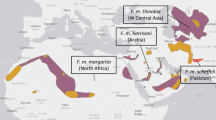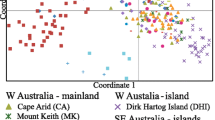Abstract.
The ocelot (Leopardus pardalis) and margay (L. wiedii) are sister-species of Neotropical cats which evolved from a lineage that migrated into South America during the formation of the Panamanian land bridge 3–5 million years ago. Patterns of population genetic divergence of each species were studied by phylogenetic analyses of mitochondrial DNA (mtDNA) control region sequences in individuals sampled across the distribution of these taxa. Abundant genetic diversity and remarkably concordant phylogeographic partitions for both species were observed, identifying parallel geographic regions which likely reflect historical faunal barriers. Inferred aspects of phylogeography, population genetic structure, and demographic history were used to formulate conservation recommendations for these species. In addition, observed patterns of sequence variation provided insight into the molecular evolution of the mtDNA control region in closely related felids.
Similar content being viewed by others
Author information
Authors and Affiliations
Additional information
Received: 26 January 1998 / Accepted: 14 May 1998
Rights and permissions
About this article
Cite this article
Eizirik, E., Bonatto, S., Johnson, W. et al. Phylogeographic Patterns and Evolution of the Mitochondrial DNA Control Region in Two Neotropical Cats (Mammalia, Felidae). J Mol Evol 47, 613–624 (1998). https://doi.org/10.1007/PL00006418
Issue Date:
DOI: https://doi.org/10.1007/PL00006418




